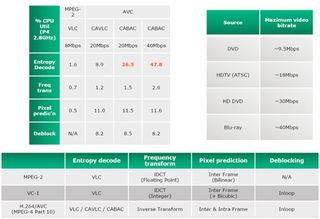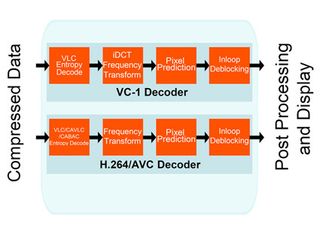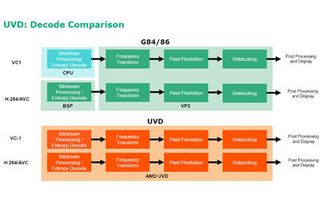R600: Finally DX10 Hardware from ATI
AVIVO-A Lot Of New Hardware
AVIVO stands for ATI Video-In Video-Out. That is exactly what it does: processing for video in and out using hardware found either on the graphics card or in the processor itself. Since its implementation on the first X1000 series cards, AVIVO did video encoding and decoding using specialized hardware as well as in conjunction with the 3D engine's shaders. ATI has reintroduced AVIVO on the HD series as well. Only this time they have made some drastic changes to the way AVIVO operates. The first change is how AVIVO does video decoding. A whole new set of silicon was created to handle all of the video decode for both HD DVD and Blu-ray.

Source: AMD (Click for a larger image)
The problem with most video decoding, especially on a laptop, is hardware acceleration without a massive power draw. MPEG-2, VC-1 and H.264/AVC decoding, if left to the CPU, will quickly ramp up utilization meaning that more power is going through it. HD DVD's have a maximum bitrate of 30 Mbps and Blu-ray is even higher at 40 MBps. The chart above shows the bit rates and the types of processing needed. In the very top left hand corner is the CPU utilization for each process on a 2.8 GHz Intel Pentium 4. To combat this problem, AMD/ATI created a single processor that can do the decoding, thus taking all of the major work away from the CPU. This new processor is called a UVD for Unified Video Decoder. While it is a processor unto itself, the silicon is actually a part of R600, much like how the 2D and 3D engines are internalized.

The UVD is the most advanced hardware decoding process on any consumer graphics card. While Nvidia may have had the first H.264 acceleration hardware with the launch of G84 and G86, it still had to have the VC-1's VLC bitstream processing decoded by the CPU. The diagram below breaks down the stages for each solution.

Click for a larger image
Another development is the location of the key for HDCP. ATI left the decision of placing a CryptoROM onto cards up to its manufacturers. This means that on an X1000 it could be possible not to have a key for HDCP. The guesswork of whether or not the full playback abilities are on your card has been eliminated. The transmitter and the keys are embedded in the ASIC.
Stay on the Cutting Edge
Join the experts who read Tom's Hardware for the inside track on enthusiast PC tech news — and have for over 25 years. We'll send breaking news and in-depth reviews of CPUs, GPUs, AI, maker hardware and more straight to your inbox.
Current page: AVIVO-A Lot Of New Hardware
Prev Page Real World For Games Next Page AVIVO-A Lot Of New Hardware (Continued)Most Popular

